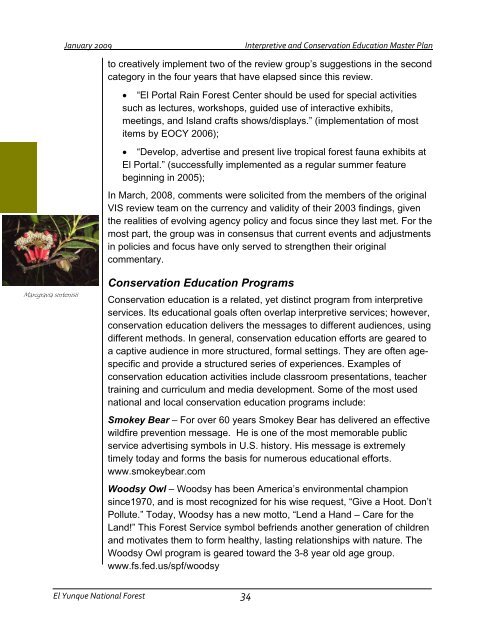2009 - USDA Forest Service
2009 - USDA Forest Service
2009 - USDA Forest Service
Create successful ePaper yourself
Turn your PDF publications into a flip-book with our unique Google optimized e-Paper software.
Marcgravia sintenisii<br />
January <strong>2009</strong> Interpretive and Conservation Education Master Plan<br />
to creatively implement two of the review group’s suggestions in the second<br />
category in the four years that have elapsed since this review.<br />
• “El Portal Rain <strong>Forest</strong> Center should be used for special activities<br />
such as lectures, workshops, guided use of interactive exhibits,<br />
meetings, and Island crafts shows/displays.” (implementation of most<br />
items by EOCY 2006);<br />
• “Develop, advertise and present live tropical forest fauna exhibits at<br />
El Portal.” (successfully implemented as a regular summer feature<br />
beginning in 2005);<br />
In March, 2008, comments were solicited from the members of the original<br />
VIS review team on the currency and validity of their 2003 findings, given<br />
the realities of evolving agency policy and focus since they last met. For the<br />
most part, the group was in consensus that current events and adjustments<br />
in policies and focus have only served to strengthen their original<br />
commentary.<br />
Conservation Education Programs<br />
Conservation education is a related, yet distinct program from interpretive<br />
services. Its educational goals often overlap interpretive services; however,<br />
conservation education delivers the messages to different audiences, using<br />
different methods. In general, conservation education efforts are geared to<br />
a captive audience in more structured, formal settings. They are often agespecific<br />
and provide a structured series of experiences. Examples of<br />
conservation education activities include classroom presentations, teacher<br />
training and curriculum and media development. Some of the most used<br />
national and local conservation education programs include:<br />
Smokey Bear – For over 60 years Smokey Bear has delivered an effective<br />
wildfire prevention message. He is one of the most memorable public<br />
service advertising symbols in U.S. history. His message is extremely<br />
timely today and forms the basis for numerous educational efforts.<br />
www.smokeybear.com<br />
Woodsy Owl – Woodsy has been America’s environmental champion<br />
since1970, and is most recognized for his wise request, “Give a Hoot. Don’t<br />
Pollute.” Today, Woodsy has a new motto, “Lend a Hand – Care for the<br />
Land!” This <strong>Forest</strong> <strong>Service</strong> symbol befriends another generation of children<br />
and motivates them to form healthy, lasting relationships with nature. The<br />
Woodsy Owl program is geared toward the 3-8 year old age group.<br />
www.fs.fed.us/spf/woodsy<br />
El Yunque National <strong>Forest</strong> 34

















